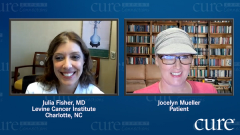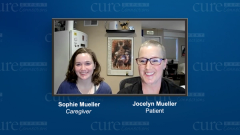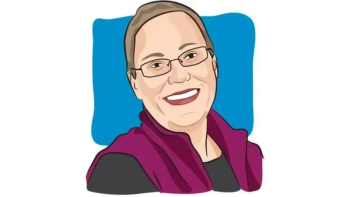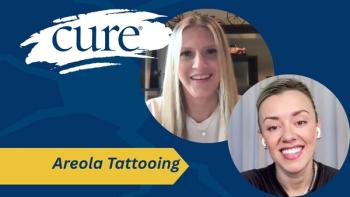
Sub-Cutaneous Versus Intravenous HER2-Targeting Post-Operative Treatment for Breast Cancer
Jocelyn Mueller, a patient with HER2-postive breast cancer, explains the recovery process after surgery and the impact that the availability sub-cutaneous HER2-targeting therapy has had on her breast cancer journey.
Episodes in this series

Jocelyn Mueller: Hello and welcome back to CURE Expert Connections on HER2+ breast cancer. My name is Jocelyn Mueller, and I am here today to give you an update on my surgery and my post-operative treatment journey, and the impact of the recent pandemic on my post-operative journey. I am joined today by my daughter, Sophie, who has been one of my caregivers and supporters during my breast cancer journey. She will share her perspective and experience of being a caregiver. I had my 6 treatments of TCHP [docetaxel, carboplatin, trastuzumab, pertuzumab], I finished that in November of 2021; and in December of 2021, I had a lumpectomy and a sentinel node biopsy. That recovery was pretty quick. I felt sore maybe for a couple days. Sophie had commented that my port placement was harder than that and as your memory tends to kind of protect you with things, I had forgotten how rough the port placement was, and I do think she was right. That was a harder procedure for me.
On December 21, I had a bilateral breast reduction, and that recovery was definitely longer. I had drains in for a week, I've had prolonged wound healing and that was far more uncomfortable and physically limiting than the lumpectomy and sentinel node biopsy was. I had known that my post-operative options that my oncologist and I talked about were dependent on the pathology report. If I did not have a complete response, if there was a cancer in my lymph nodes still, I would have switched from Herceptin [trastuzumab] and Perjeta [pertuzumab] to Kadcyla [ado-trastuzumab emtansine]. If I had a complete response and no evidence of cancer, I would stay on trastuzumab and pertuzumab and if I did that, I had the option — if my insurance would pay for it — to switch to Phesgo [pertuzumab, trastuzumab, and hyaluronidase-zzxf] which is the subcutaneous version. And luckily, I had a complete pathological response, no residual disease in my tumor; they only took out 2 lymph nodes and they were clear and again, I’m also very fortunate that my insurance did to cover the Phesgo, so I switched after having two, just Herceptin and Perjeta, and then starting in early January, I had my first shot. My questions for that was how big is the shot, because I knew that my Herceptin and Perjeta bags were two separate IV bags that would go in my port and they were probably about 8 to 10 ounces of liquid, they need more than that, so I was wondering how large the shot would be and worried that I would have a lump under my skin. Dr. Fisher explained to me, the shot is 10 mL, it's 2 teaspoons of liquid and it's given in your thigh. They switch from one side to the other each time. I just had my 3rd one last week and I didn't have to make very many adjustments. A nice adjustment I got to make by switching to Phesgo was I got my port removed, which was an excellent day. That was something that made me very uncomfortable, so I was happy to be done with it. I knew that the long-term goals are that I stay on Herceptin and Perjeta product, whether it's IV or subcutaneously, for a complete year to reduce my chance of recurrence, and it drastically reduces that for women with HER2+ breast cancer.
One of the big life-changing things with being able to stay on Herceptin and Perjeta was I got to switch to Phesgo, which is the combination of Herceptin and Perjeta in a subcutaneous shot form. It's given in your thigh and it's about 2 teaspoons of liquid versus 2 IV bags about, I don't know, this big that they put in your port if you have one. If not, through an IV. Each 1 given over 30 minutes. So you're sitting, waiting for the pharmacy to do the drugs, waiting for them to get them to you and put on your IV pole and start the pump going and with the shot, they literally obviously you're still waiting for the pharmacy but they get the shot, they come in, clean your leg off, and it takes them five minutes to give it which is more awkward for the nurse than it is for me because they're bent over on a stool leaning down, putting this in my leg for five minutes. And then we're done, they put a band-aid on me and that's it. There's not much less of my time, I feel more normal again because I don't have the port. Like Sophie said, the port is a constant reminder that I'm dealing with all of this and not that you really forget but having that, being able to take that out and get a shot in my leg is huge. It's liberating. I don't dread. I don't love the fact that I have shots through July 12th every 3 weeks but it's a lot easier to deal with than infusions every 3 weeks through July 12th.
That has been life-changing, I would say, and like I said, I was lucky enough that my insurance is covering it and if your insurance will cover it, if your clinic doesn't do this, you need to push them to do it or you should do this on your own. The manufacturers of a lot of these drugs will do prescription cards for lack of a better word. The best example I can use is my older daughter is a Type 1 diabetic and when she was newly diagnosed, someone told me to go to Novo Nordisk and fill out this card, and we went from paying several hundred dollars for her small amount of insulin to about $75 for a larger amount of insulin because the insurance company or the manufacturer will do that if you take the time to go out and fill this card out. Levine Cancer Institute has a group that did that for me, so that drastically reduced what I will pay out of pocket for the Phesgo after my insurance covers their piece, which I definitely would encourage people to look into and I really hope for the sake of all of us having to do this that the subcutaneous delivery will be covered for the people where it's medically appropriate for them to stay on Herceptin and Perjeta, I hope it gets to a point where it's approved for everyone.
Sophie Mueller: I'll just say that the day that she got her port removed was pretty wonderful because that was just something that reminded her of everything that had happened the past couple of months and it was just a lingering cancer item that was just sticking right out of her skin right here. So, every time she looked in the mirror, she would see her port but now that it's gone, like every day, she'll be like "Oh, I can touch my neck and it's not weird" or "Oh, this looks so much more normal. Oh, look at the scar, it's so much more healed" and it's just so nice to see that and see how much easier it is on her, especially because this will be going on until July.
Jocelyn Mueller: You definitely learn along this road that any little things that you can celebrate you should celebrate as much as possible because so much of this journey is not fun at all.
Transcript edited for clarity.







